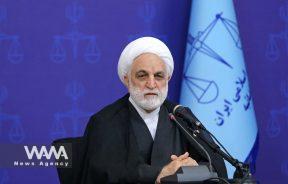The Military Formation in the Northern Front One Year After Operation Al-Aqsa Storm
WANA (Oct 09) – One day after the start of Operation Al-Aqsa Storm, the northern front of occupied Palestine also became active with Hezbollah’s operations in support of Gaza. While the intensity of the conflict in this front remained limited until two weeks ago, it has recently become a primary battlefield. This article examines the military strategies of the Israeli regime and Hezbollah in this front.
The Israeli Regime’s Strategy in This War Consists of Three Pillars:
1. Disrupting the Command Network
The first pillar of the Israeli regime’s strategy is to disrupt Hezbollah’s command network, essentially aiming to “cut off the head” of Hezbollah. This tactic has been pursued through targeted assassinations of field commanders during limited border skirmishes. Israel continued this approach, step by step, after Hezbollah refrained from responding to the assassinations of Saleh al-Arouri and Fuad Shukr in Beirut, by eliminating senior command personnel, the leadership of the Radwan Forces, and Hezbollah’s general secretary.
Although the intensity of this approach has decreased after the early days of the invasion of Lebanon, with most of the senior military commanders and key figures in the rocket, missile, and drone units eliminated, Israel continues to target mid-level field commanders in southern Lebanon and other influential leaders.

Details of the Assassination of Hassan Nasrallah: Possible Use of Cyanide Gas by Israel
WANA (Oct 02) – The assassination of Hassan Nasrallah, Secretary-General of Hezbollah, was likely carried out by the Israeli military using advanced tactics. According to information shared by General Abdolfattah Ahvazian, a senior commander of the Islamic Revolutionary Guard Corps, the attack involved an unprecedented amount of bunker-busting bombs. It is reported that approximately […]
2. Utilizing Air Superiority
The second pillar of Israel’s strategy is the use of absolute air superiority to destroy Hezbollah’s military capabilities, reduce its own casualties, and exert pressure on Lebanon’s civilian population.
Daily footage of Hezbollah’s ammunition and rocket depots being struck and identified by secondary explosions following airstrikes is broadcasted. At the same time, Israel is expanding evacuation zones, clearing civilians from southern Lebanon and north of the Litani River.
Israel’s ongoing attacks on civilians and medical personnel further incentivize the evacuation of southern Lebanon’s population, ultimately making any long-term occupation much easier for Israel.
Israel’s continued success in targeted assassinations, the attrition of military power, and the destruction of Hezbollah’s depots highlight its strong intelligence advantage. While part of this superiority can be attributed to Israeli technical capabilities, infiltration into Hezbollah remains a persistent problem. Hezbollah now faces the difficult task of reorganizing its leadership and command structure while addressing the issue of infiltration under unprecedented military pressure.

Hypotheses on the Next Destabilization Attempts by the U.S. and Israel
WANA (Oct 08) – Following the destruction of Gaza, the martyrdom of Hamas leaders, and efforts to suppress resistance groups, Israel is now aiming to dismantle the political structures in Gaza. The goal is to merge Gaza with the Palestinian Authority, but this project requires eliminating and weakening the arms of resistance. From Israel’s […]
3. Limited Ground Operations
Despite airstrikes and targeted assassinations, these measures alone are insufficient to eliminate the Hezbollah threat. Therefore, the third pillar of Israel’s strategy is launching limited ground operations aimed at destroying Hezbollah’s military positions and capabilities in southern Lebanon, with the possibility of a prolonged occupation later. Published images confirm the presence of at least two infantry brigades, two armored brigades, one artillery brigade, one commando brigade, and one paratrooper brigade in Israel’s operations in Lebanon.
Current operational areas of the Israeli army are in the axes of the villages and towns of Maroun al-Ras, Yaroun, Kafr Kila, and Adaisseh, located just a few hundred meters from the border.
Israel’s military strategy aims to minimize its own casualties in ground operations. Its usual armored strike tactic has not yet been executed due to Hezbollah’s effective anti-armor weaponry. The current tactic involves ground forces advancing toward border villages and towns, attempting to clear them.
While all indications suggest Israel’s intent to expand its operational areas and pursue permanent occupation, at this stage, Israeli soldiers, despite multiple incursions into border areas, are not pushing for swift consolidation of control or breaking Hezbollah’s resistance. Israel also relies on heavy and disproportionate airstrikes against any resistance, with reports of up to twenty airstrikes on a single village within 24 hours.

Hezbollah’s Missile City: The Underground Game That Disrupted Regional Equations
WANA (Aug 19) – Hezbollah has sent a significant message to its adversaries by unveiling an underground missile city in the mountains of Jabal Amel: a repetition of what happened in Gaza will not be possible in Lebanon. This move came especially after the assassination of resistance commanders Ismail Haniyeh and Fouad Shukr, which […]
Hezbollah’s Strategy and Response
Despite the painful blows to Hezbollah’s organization and military capacity, the defenders’ performance in southern Lebanon has been commendable. Hezbollah’s strategy at this stage is to avoid direct confrontation and instead rely on roadside bombs, explosive traps, and ambushes against advancing Israeli forces, successfully inflicting casualties on the Israeli attackers.
So far, Israel’s army has been unable to fully secure the border villages due to Hezbollah’s resistance. If this resistance continues successfully, it is expected that Israel’s progress will remain slow, and the Israeli army will face significant costs.












